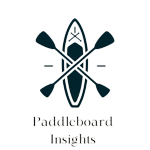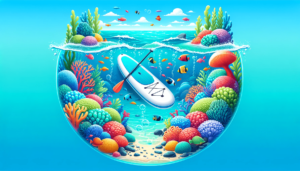Did you know that paddleboarding is one of the fastest-growing water sports in the world?
If you’re a beginner looking to take on the ocean, there are a few helpful tips that can make your experience much smoother.
This article will provide you with eight essential tips to get you started on your ocean paddleboarding journey.
From choosing the right board to mastering the proper technique, you’ll be well-equipped to navigate the open waters with confidence and freedom.
Choose the Right Paddleboard
Beginners should select a paddleboard that suits their skill level and ocean conditions. When it comes to choosing the right paddleboard, there are several considerations to keep in mind.
First and foremost, beginners should opt for a stable and wide board. This will provide them with the necessary balance and confidence as they learn the ropes of paddleboarding.
Additionally, the length of the board is essential. Longer boards are more stable in calm waters, while shorter ones offer better maneuverability in choppy conditions.
It’s also important to consider the volume of the board. Higher volume boards are more buoyant, making them ideal for beginners. On the other hand, lower volume boards are more suited for experienced paddlers who want to ride waves.
Lastly, there are different types of paddleboards available, including all-around, touring, and surfing boards. All-around boards are versatile and suitable for various conditions, while touring boards are designed for longer trips. Surfing boards, as the name suggests, are tailored for riding waves.
Learn the Proper Paddling Technique
To master the proper paddling technique in ocean paddleboarding, beginners must focus on three key points.
First, hand placement is crucial for maintaining balance on the board.
Second, engaging the core muscles is essential for generating power and stability during the paddle stroke.
Hand Placement for Balance
Proper hand placement is essential for maintaining balance and learning the correct paddling technique while ocean paddleboarding. The hand placement technique on the paddle is crucial to ensure paddleboard stability and prevent unnecessary wobbling.
When gripping the paddle, beginners should make sure to place their bottom hand on the handle, while the top hand should be positioned on the shaft, slightly higher than shoulder-width apart. This hand placement allows for better control and stability, enabling paddleboarders to navigate through the ocean with ease.
By positioning their hands correctly, beginners can find a comfortable and balanced stance, which is essential for a smooth and enjoyable paddleboarding experience.
Now, let’s shift our focus to core engagement for power, which will enhance your paddleboarding skills even further.
Core Engagement for Power
Continuing from the previous subtopic on hand placement, paddleboarders can enhance their skills and improve their technique by engaging their core muscles for added power. Strengthening exercises focused on the core can greatly benefit paddleboarding, as they help stabilize the body and generate more force during each stroke.
Here are some important points to consider:
- Incorporate exercises like planks, Russian twists, and bicycle crunches to strengthen the core muscles.
- Maintain proper body alignment by keeping the shoulders relaxed, back straight, and hips stable.
- Engage the abdominal muscles by pulling the belly button towards the spine during each stroke.
By strengthening the core and maintaining proper body alignment, paddleboarders can maximize their power and efficiency in the water. This will ultimately lead to a more enjoyable and satisfying paddleboarding experience.
In the next section, we’ll delve into the importance of an efficient paddle stroke.
Efficient Paddle Stroke
Paddleboarders can improve their technique and maximize their efficiency in the water by learning the proper paddle stroke.
The key to an efficient paddle stroke is to focus on body alignment and technique. First, ensure that your body is properly aligned on the paddleboard, with your feet shoulder-width apart and your knees slightly bent. This will provide stability and balance, allowing you to paddle more efficiently.
Next, hold the paddle with both hands, making sure to keep your arms straight and your grip firm but relaxed. Engage your core muscles and rotate your torso as you reach forward with the paddle, submerging it fully into the water. Finally, pull the paddle back towards you, using your core and upper body strength to generate power and propel yourself forward.
By mastering the proper technique, you’ll be able to paddle with ease and enjoy the freedom of gliding through the water.
Now that you understand the importance of efficient paddle stroke, let’s move on to the next step: starting in calm and shallow waters.
Start in Calm and Shallow Waters
To gain confidence and build foundational skills, beginners should begin their ocean paddleboarding journey in calm and shallow waters. Starting in calm water provides several benefits for those new to paddleboarding.
Firstly, it allows beginners to focus on their balance and stability without the added challenge of navigating through rough waves. This creates a safe and controlled environment for practicing basic paddling techniques.
In addition to calm water benefits, starting in shallow water also offers advantages for beginners. Shallow water provides a sense of security as it allows paddlers to easily touch the ground if they lose balance or fall off the board. This reassurance can help beginners overcome any fear or anxiety they may have about falling into the water.
To further enhance the experience, beginners can follow these tips when starting their ocean paddleboarding journey:
- Choose a location with minimal boat traffic to ensure a peaceful and uninterrupted paddle.
- Wear a personal flotation device (PFD) for added safety and peace of mind.
- Begin paddleboarding during low tide when the water is shallower and more manageable.
By starting in calm and shallow waters and following these tips, beginners can gradually build their skills and confidence, paving the way for more adventurous paddleboarding experiences in the future.
Wear the Right Gear and Safety Equipment
When it comes to ocean paddleboarding, wearing the right gear and safety equipment is crucial for a safe and enjoyable experience on the water.
First and foremost, a proper fitting personal flotation device (PFD) is essential. It should be worn at all times to ensure buoyancy in case of a fall or unexpected weather conditions.
Additionally, a leash is a must-have accessory to keep the paddleboard attached to the rider. This prevents the board from drifting away, allowing the paddler to stay close to their board and easily climb back on if they fall off.
In terms of clothing, it’s recommended to wear a wetsuit or rash guard to protect against the sun, wind, and potential cold water temperatures.
Lastly, a waterproof whistle is a small but important piece of gear that can be attached to the PFD. It can be used to signal for help in case of an emergency.
Practice Good Balance and Body Positioning
When on the water, beginners should focus on maintaining good balance and body positioning to enhance their ocean paddleboarding experience. Improving stability and body alignment is crucial for a successful and enjoyable paddleboarding session. Here are some helpful tips to keep in mind:
-
Engage your core: Keep your core muscles engaged throughout the entire paddleboarding session. This will help you maintain stability and control over your board.
-
Distribute your weight evenly: Make sure to distribute your weight evenly on your board. Stand in the center of the board and avoid leaning too far forward or backward, as it can throw off your balance.
-
Bend your knees: Keep your knees slightly bent to absorb the movements of the water. This will help you stay balanced and adapt to any changes in the ocean’s surface.
Be Aware of Ocean Conditions and Weather
Beginner paddleboarders must be well-informed about ocean conditions and weather to ensure their safety on the water.
It’s crucial to understand how changing conditions, such as tides, currents, and waves, can affect paddleboarding experiences.
Additionally, being aware of weather patterns, such as strong winds or storms, is essential for avoiding potential dangers and planning paddleboarding sessions accordingly.
Safety in Changing Conditions
To ensure safety while paddleboarding in the ocean, beginners should always be aware of changing conditions and weather. The ocean is a dynamic environment, and being prepared for shifting tides and weather patterns is essential. Here are some safety precautions to keep in mind:
-
Stay updated on changing tides: Before heading out, check the tide charts to know when the tide will be rising or falling. This will help you plan your paddleboarding session accordingly and avoid dangerous situations.
-
Wear a personal flotation device (PFD): Even if you’re a strong swimmer, it’s crucial to wear a PFD for added safety. It will provide buoyancy and keep you afloat in case you fall off your board.
-
Check the weather forecast: Keep an eye on the weather conditions, especially for any approaching storms or strong winds. It’s best to paddleboard on calm days with clear skies to ensure a safe and enjoyable experience.
Impact of Weather Patterns
The impact of weather patterns on ocean paddleboarding can significantly affect the conditions and safety for beginners. Weather conditions such as wind, waves, and current play a crucial role in determining the paddleboarding experience. When planning a paddleboarding session, it’s important to check the weather forecast and be aware of any potential changes in conditions.
In extreme weather conditions, safety precautions should be taken to ensure the well-being of beginners. It’s recommended to avoid paddleboarding in strong winds or storms, as they can make it difficult to control the board and pose a risk of capsizing. Additionally, it’s important to be mindful of the water temperature and dress accordingly to prevent hypothermia.
Learn How to Navigate and Steer Your Board
Navigating and steering your board is essential for ocean paddleboarding beginners. It allows you to explore the vast ocean and experience the freedom that comes with gliding across the water. To help you become more proficient in this aspect of paddleboarding, here are some tips to keep in mind:
-
Get a feel for your board: Spend some time getting comfortable on your paddleboard before attempting to navigate or steer it. This will help you understand how it responds to your movements and weight distribution.
-
Master your paddle strokes: Learning different paddle strokes will give you more control over your board. Practice the forward stroke, reverse stroke, and sweep stroke to effectively maneuver your board in various situations.
-
Use your body to steer: Instead of relying solely on your arms, use your body to steer the board. Shift your weight and engage your core muscles to initiate turns and maintain balance.
By mastering these ocean paddleboarding techniques, you’ll be able to fully enjoy the benefits of ocean paddleboarding. These include connecting with nature, improving your fitness level, and experiencing a sense of freedom like no other water sport can provide.
Follow Proper Etiquette and Respect Marine Life
When paddling in the ocean, it’s important for beginners to adhere to proper etiquette and show respect for marine life. Following these guidelines not only ensures a safe and enjoyable experience but also contributes to marine conservation efforts.
One of the most crucial aspects of proper etiquette is maintaining a respectful distance from marine wildlife. While it may be tempting to get up close for a better look or photo opportunity, it’s essential to remember that ocean wildlife interaction should be on their terms. Disturbing or harassing marine creatures can cause stress, disrupt their natural behavior, and even put them at risk. As paddleboarders, we should strive to be passive observers, keeping a respectful distance and refraining from touching or feeding any animals we encounter.
In addition to respecting marine life, it’s also important to practice responsible behavior that contributes to marine conservation. This includes avoiding littering or disposing of any waste in the ocean, as well as being mindful of the impact our actions may have on the marine environment. By being conscious of our choices and minimizing our ecological footprint, we can help preserve the beauty and health of our oceans for future generations.
Frequently Asked Questions
How Do I Choose the Right Paddleboard for My Body Type and Skill Level?
Choosing the right paddleboard for your body type and skill level is crucial for a successful ocean paddleboarding experience. Consider body type, assess skill level, try before you buy, consider conditions, and seek professional advice.
What Are Some Common Mistakes to Avoid When Learning the Proper Paddling Technique?
Common mistakes to avoid when learning proper paddling technique include using the wrong hand placement, not engaging the core muscles, and improper body positioning. These errors can hinder progress and cause unnecessary strain.
How Can I Effectively Navigate and Steer My Paddleboard in Different Ocean Conditions?
To effectively navigate and steer a paddleboard in different ocean conditions, beginners should learn various ocean paddleboarding techniques. They should also prioritize paddleboard maintenance and care to ensure a smooth and enjoyable experience on the water.
What Are Some Important Safety Measures to Follow While Paddleboarding in the Ocean?
When ocean paddleboarding, it is crucial to follow essential safety measures to stay safe on the water. These measures include wearing a leash, using a personal flotation device, checking weather conditions, and staying within your skill level.
How Can I Show Respect for Marine Life and the Environment While Paddleboarding?
To show respect for marine life and the environment while paddleboarding, one should practice marine life conservation and adopt eco-friendly paddleboarding practices. This ensures a harmonious coexistence with nature and a sustainable future for all.


